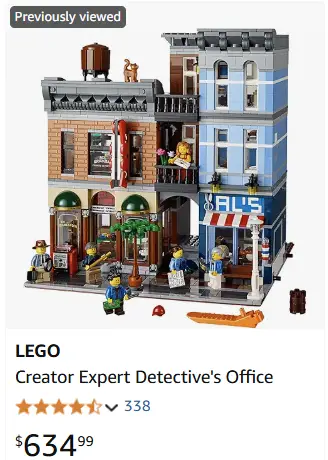
I’ve always had questions on this topic, but this is for anyone who hasn’t seen my stuff on this or heard me speak on it before. It’s an important thing to understand when it comes to values rising in the after-market.
The Q4 Hype: Is It Really the Best Time to Sell?
So, we all know the drill: Q4 (October through December) is the hot season for selling. Demand spikes, shelves empty out, and prices often climb as holiday shoppers go wild. It’s the obvious choice, right? You’d think that’s when LEGO sets—especially retired ones—see their biggest appreciation. But here’s the thing: after looking at a bunch of sets across different themes (modulars, Ideas, Architecture, Speed Champions—you name it), I’m starting to see that Q4 might not always be the golden ticket we assume it is.
Take the Creator Expert Detective’s Office, for example.
This $160 set retired in late 2018, and bumped up to around $240-$260 in that first Q4.
Solid, right? But then something weird happened: it flatlined for the entire second half of 2019. No growth. Zip.
Then, come January 2020, it shot up again—hitting $300 by July. Same deal in 2021: started at $497, climbed to $600 by mid-year, then flatlined again.

Three years of data, and the pattern’s clear: the first half of the year (January to June) is where the real appreciation often happens. Q4? It’s more of a setup than the main event.
Digging Into the Data
I didn’t just stop at one set.
I pulled up nine random retired sets to test this hunch—stuff like Voltron, Parisian Restaurant, Brick Bank, Guggenheim, Chicago, Porsche 911 Turbo, Old Fishing Store, and Yellow Submarine.
Not cherry-picked, just whatever popped into my head from 2018-2019 retirements.
And guess what? Seven out of nine showed the same trend: bigger price jumps in the first half of the year, with the second half either flatlining or barely creeping up.
- Brick Bank: Retired in 2018, went from $170 retail to $270 by July 2019 (first half growth). Second half? Stuck at $274. Then bam—January 2020 hits, and it’s $430 by February, $490 by July. Second half of 2020? Only a $60-$70 bump.
- Chicago (Architecture): Retired 2019, doubled from $30 to $63 by July. Second half? Flat. 2020’s first half? Rocketed to $130. Flat again after July.
- Porsche 911 Turbo: $12 to $22 in the first half of 2019, then just $5 more in the second half. 2020? $27 to $39 in the first half, then lost a dollar until a late December bump.
Even sets like Voltron and Old Fishing Store followed suit—strong first-half gains, weaker second halves. Yellow Submarine was an outlier (more even growth), but the trend held strong overall.
Why Does This Happen?
Here’s my theory: Q4’s insane demand shakes out the low-ball sellers—those folks listing tons of sets at rock-bottom prices for quick sales.
Once they’re gone (usually by December), the supply tightens, and prices start climbing in January as the market adjusts.
That appreciation often peaks by June or July, then stalls out as the market stabilizes until the next Q4 shake-up.
It’s like Q4 is the spark, but the first half of the year is the fire.
So, When Should You Sell?
This got me thinking: if the big gains hit in the first half, why are we all obsessed with selling in Q4?
Sure, December can give you a quick bump (and it’s great for moving inventory fast), but what if we stretched our hold times a bit?
Say, instead of a 12-month flip, we aim for 18 months—selling in June or July after a set retires in December?
- Detective’s Office: Buy at retirement ($160-ish), sell after 12 months in Q4 2019? Maybe $240. Hold 18 months to July 2020? $300+. Huge difference.
- Chicago: $30 at retirement, $60 after 12 months in Q4 2019. 18 months to July 2020? $130. That’s over 4x your investment.
- Brick Bank: $170 to $275 after a year. 18 months to July 2020? $490. You’re leaving money on the table with the shorter hold.
The catch? Demand’s lower in July than Q4, so you’d need to price at market (e.g., $124 if that’s the going rate) rather than aiming high and waiting for buyers to bite. But LEGO still sells fast year-round—set the right price, and it’ll move.
What’s the Play Here?
I’m not saying ditch Q4 entirely—it’s still a powerhouse for quick flips.
But if you’re holding sets that retire late in the year, waiting an extra six months could catch that first-half wave of growth. It’s a trade-off: 18 months slows your compounding (faster flips = more cycles), but the higher returns might make up for it.
For sets that don’t jump much in their first Q4 (like Chicago in 2019), holding through to mid-next-year could be the move.
This isn’t set in stone—nine examples aren’t the whole market. I’m digging deeper with more data, but the signal’s strong enough to make you think twice.
What’s your take?
Are you a Q4 diehard, or do you see the value in a mid-year cash-out?
I go much deeper into these topics in my book, Winning Set Secrets, which breaks down my approach to LEGO investing. If you haven’t read it, I assume you hate money…it’s the only logical explanation!
